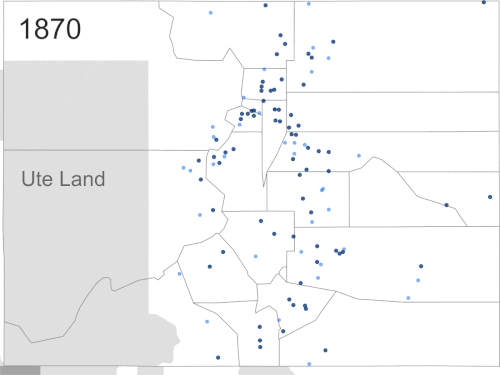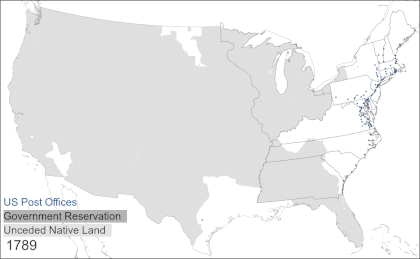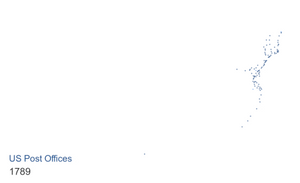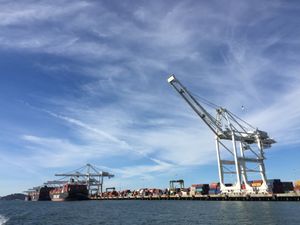A conversation with Cameron Blevins on the operational history of the USPS
As American settlers headed west in covered wagons to make their fortunes, the United States postal service followed along in lockstep. The story of westward expansion in America is a story of empire through infrastructure - but not the carefully planned infrastructure that is familiar to us today. Cameron Blevins, associate professor at the University of Colorado Denver, uncovers and analyzes these trends in his new book, Paper Trails: The US Post and the Making of the American West. Using an incredible dataset of post offices, he mapped the growing network to understand how USPS's expansion mirrors migration patterns, politics, and the nature of the federal government’s relationships with both citizens (who were encouraged to settle and transform inhospitable lands through policies like the Homestead Acts) and Indigenous people (as the government waged successive wars, expropriated land, and created the reservation system). These visualizations uncover how the US Post shaped the West through its expansive and fast-moving network and can be explored in-depth on the companion website, Gossamer Network.
Scope of Work's Member’s reading group recently read Paper Trails, and afterwards we invited Cameron to have an hour-long conversation about the book, his methods, and the organizational history of the USPS. What follows is an edited and condensed transcript of our discussion, which included Cameron, Spencer, and other Members of Scope of Work.
Spencer Wright: Paper Trails is about the USPS in the 19th century, and a lot of the points that you make earlier early in the book are about how data can inform our understanding of the USPS and American westward expansion. But the meta points that you bring up are really about organizational design. The USPS relied on private citizens to act as postmasters in order to provide mail services. You call this the agency model, and it allowed the US Post to dwarf every other postal system on earth. In other words, the USPS was blitzscaling, growing an operation really quickly, in an uncontrolled way, similar to technology companies today. Could you speak to USPS's organizational structure in the mid 19th century and how that affected its growth, and the development of US Federal bureaucracy?
Cameron Blevins: So, it's interesting, I didn't approach this project from an interest in the US postal system and its institutional history. The origin of this project was a seminar paper looking at the historical geography in the western United States. I was trying to figure out a way to map out shifting demographics of where people were moving on a more fine-grained scale than the census, which is every 10 years, and at the county level. I hit upon the idea of using a post office as a proxy for a surrounding community. If you could figure out where and when a post office opens, you can trace out more fine-grained patterns.
I came into this research with the impression of the modern US postal system, a large top-down government bureaucracy. But when I started looking at the data, I was just blown away by how many of these post offices in the West were opening and closing within a matter of months or years. That was just such a different model, and I had to ask: “What explains this?" You see these patterns where hundreds of post offices disappear in the span of a year. It’s so different from the government bureaucracy that we have today. With the data, I started asking, "How does the system even work?" It's a miracle that letters are even traveling across such an unstable network.

Ultimately, that's how I stumbled into the idea of the agency model and began to understand this decentralized organization. The 19th century USPS was really grafting a public service onto private infrastructure. When we're thinking about designing systems, I think you hit it on the head: There were some policies put into place, but again and again, I was reminded of the image of Mickey Mouse in Fantasia, casting the spell with the brooms, and then suddenly, they're carrying water, and suddenly there's flooding. It's marching out of control! That's not to say that the entire system was completely chaotic, there were some top-down organizational policies that provided structure -but fewer than I was expecting.
SW: I imagine there was a lot of debate within the US federal government, at that time, about these policy decisions and how the postal system would be implemented. Do you have a sense of how well the implications of the agency model were understood at the time?
CB: Oftentimes, there are decisions made at the very beginning when a system is designed that end up propagating in strange ways. For the US Post, at the nation's founding, Congress decided that this system was dedicated to providing an accessible service to the entire population. After the Revolutionary War, there are 13 disparate states, and the post was a tool to keep them together. Richard John wrote a book, Spreading the News, that covers the period before my book and he articulates the way the USPS was dedicated to subsidizing public news across this new nation.
Now, what's interesting of course, is how that dedication to providing accessible service carries through 50 years later when the nation is no longer 13 states hugging the Atlantic seaboard but now spans a continent. One major top-down policy that has an impact on the west is the decision to stop factoring distance into the cost of postage. It doesn't matter if you're sending a letter from New York to New Jersey, or if you're sending a letter from New York to the middle of nowhere, Montana, the cost to the sender is the same. In reality, this ends up being really expensive for the government but they are committed to providing that service. I think this leads to a lot of the interesting structural things, like the agency model, in the west. You have this marriage of an ideological commitment to universal public service, with the on-the-ground logistic challenges of then providing that service.
SW: In a couple of cases in the book, you make a point that the American West was heavily subsidized by the federal government. Is this idea that the American West was subsidized a contentious claim? And how do these ideas land with people who live in the American West now?
CB: I'm guessing most of us grew up with a certain vision of Western history where it's cowboys and Indians, pioneers and covered wagons. In this vision, the government is nowhere to be found. There is still a flavor of that today, but more importantly, Americans writ large, not just in the West, don't entirely recognize the ways in which the federal government shapes their lives. We are reliant upon all of these networks and systems put in place - systems that often are rarely seen. Suzanne Mettler calls it the Submerged State, where aspects of society are resting on an edifice of public subsidies, but in the context of the US government, these aren’t broadly acknowledged.
This is a big issue with something like healthcare, for instance. The effects of Obamacare were largely submerged, and people didn't realize that all of these benefits they were getting were directly flowing from those policies. Another example would be the fact that you can drive up I-70 into the mountains, and pass by all of these federal forest lands that have to be maintained. Or consider defense contracts, which are a huge thing in the West. San Diego or Phoenix would not exist as they are today without defense contracts. There are all these different ways both historically and today that the state shapes our lives. Getting into those hidden structures is what is really fascinating to me.

Jason Luther: I have a follow-on to that. Government plays a huge role in the USPS today and we can do really cool things like making sure everyone has access to the post - and less explicitly cool things like pre-funding pensions. So I’m curious about the contemporary USPS which is legally mandated to be self-sustaining. What was the logic of Congress in making that decision, and how did they justify saddling USPS with this huge responsibility without being able to run publicly funded deficits?
CB: Yeah, you are hitting the nail directly on the head, in my opinion. The establishment of the modern USPS in 1970 was spurred in part by a series of institutional crises. There was this giant backlog of mail at the Chicago post office, which basically crippled mail service for a week or two. There was also a giant postal strike in 1970. At the time, it was the largest ever wildcat strike, with about 200,000 postal employees off work for seven or eight days. These events coincide with nascent Reagan-era ideas of the private sector being more efficient through privatization. All of that leads to the creation of this public-private hybrid where basically it cuts the USPS off from taxpayer funding, requiring the service to be self-sufficient.
But rural Congress members are like, "Well, wait a second. If we do that, I'm going to have all these constituents that will suddenly not have a post office, because it's too expensive to carry the mail to the middle of nowhere." These congress members had a lot of political power and ensured that the modern USPS cannot cut service in rural areas. This is the reason why the USPS as it is today has been called a Frankenstein or a Jackalope. There are expectations of being self-sufficient that are frequently contravened by congressional influence. This is where pre-funding retiree benefits come in.
I think the other drastic piece of this is the fact that communications in 2021 are completely different from 1970. First-class mail, or letters, peaked in 2001, and today’s volume is down by about half. If your entire revenue model is based around physically carrying things through the mail, you're in trouble no matter what. For me, in 2021, it's more a question of what do we want this to be? I have pretty clear opinions on that: The USPS is a public service, and it doesn't make sense that it should be self-sustaining. We don't ask other parts of the government to be completely revenue positive. It's also important to have that be a conscious decision rather than just this kind of Frankenstein thing that's lumbering forward. I think there's, on the flip side, a danger in appealing too much to history. While the USPS was never meant to be self-sustaining, I don't particularly care what guys in wigs in the 1780s thought. It matters what we want this institution to look like in 2021 and beyond.
Victoria Dower: I worked in telecommunications and a lot of the issues brought up in the book, especially around rural free delivery, sounded very familiar. Telcos complain about subsidizing rural broadband or how services like Netflix and Zoom build their businesses off their back, which mirrors how USPS subsidized mail delivery and discounted periodicals and mail-order catalogs. I'd love your perspective on what about telecommunications infrastructure feels resonant with your research.
CB: Again, historian Richard John wrote a very resonant book, Network Nation, which is a history of telecommunications immediately after the Civil War through the early 1900s. What's really interesting is that because the US Post is a public entity (although it is continually grafted onto private infrastructure) it becomes a model for what an effective, efficient government service can look like for reformers during the Progressive Era. It is really upheld as a model of what good government could be, in providing this massive, geographically expansive service. Particularly because it is providing a universal service to all Americans, especially rural parts of the country, and is not pursuing a profit motive. So, there are calls by these reformers for the USPS to take over the telegraph and telephone industries.
Now, it never happened. We all know that. However, I think the fact telecommunications has been private from the beginning has ripple effects all the way into the present. Today we’re still wrestling with the ideological reticence of many Americans against public ownership of different sectors of the economy. There's obviously good and bad to that, but I think it’s valuable to remember this is history rippling to the present.
Thanks to Cameron for joining the conversation, and to James, Jason, Hillary, and Victoria for bringing excellent questions. Starting next week, we’ll be reading The Big Score: The Billion-Dollar Story of Silicon Valley, by Michael S. Malone. Join as a Member today to join us when we chat with Michael in September.




